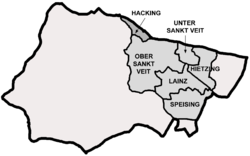Hacking (Vienna)
| Hacking | |
|---|---|
| coat of arms | map |
 |

|

Hacking is a former suburb and now part of the 13th district of Vienna Hietzing as well as one of the 89 Viennese cadastral communities .
A small part of the cadastral community (in the area of the Hütteldorf train station ) belongs to the 14th district of Penzing .
location
Hacking is located on the right bank of the Wien River on the western outskirts of Vienna. Hacking borders Hütteldorf to the north , Ober Sankt Veit to the east and is bordered by the Lainzer Tiergarten (cadastral community Auhof ) in the southwest .
history
Hacking was first mentioned in 1156 as Hacingen after Markwardus de Hacingen , a follower of Margrave Heinrich II von Babenberg. The place arose on the slope of the Hackinger Berg (today Hagenberg ) below the Hackinger Castle , which was first mentioned in the 13th century and can be traced back to a landlord Haggo. The last three mayors were Vinzenz Hess (1851–1879), Gustav Seidel (1880–1887) and Michael Pfeiffenberger (1888–1891). In 1892 Hacking was incorporated into the 13th district of Hietzing in Vienna. Hacking separated the district boundary drawn in 1938 into two parts, in particular the southern part of the Hütteldorf train station with the historic reception building and the industrial property adjacent to the east on Deutschordensstraße (today Morawa book delivery and parking deck) came to the newly formed 14th district.
The Vienna river construction and the traffic artery of the western entrance , which has been brought closer to the river, represent a clear boundary of the district to the north, which has not grown historically. The construction of the Westbahn and the connection through the Hütteldorf train station also made the Hacking part of the district interesting for urban development in the second half of the 19th century, as evidenced by some Wilhelminian style villas in the Auhofstrasse area and the Hacking sanatorium (today St. Josef Hospital Vienna ) .
Today, life in this part of the district is strongly influenced by the Dominican school and opposite the youth hostel of the City of Vienna, while the Himmelhof (formerly ski jumping hill ) has largely lost its importance as a ski and recreational area for Viennese from other districts. The Lainzer Tiergarten , which can be reached through the Nikolaitor at the corner of Himmelhofgasse and Nikolausgasse, no longer has the same recreational significance as it was in the 20th century after it opened to the public.
Auhofstrasse and Schlossberggasse to Ober Sankt Veit as well as the western entrance (Hackinger Kai or Bundesstrasse 1 ) represent the most important traffic arteries in the district.
Personalities
- Max Mell (1882–1971), poet, lived in Hacking from 1919; The Max Mell Park on Erzbischofgasse was named after him in 1985.
See also
Web links
- Entry on Hacking (Vienna) in the Austria Forum (in the AEIOU Austria Lexicon )
- Hacking on the wien.at website
- hietzing.at - Hacking
- Hacking in old views on the VHS Hietzing website
- Hacking in the district museum Hietzing
- Hacking, excerpt from Weissenbacher, G. (1996) on 1133.at
- Hacking, in a nutshell at 1133.at
Individual evidence
- ↑ Weigl, Heinrich: Historical book of place names of Lower Austria . Association for regional studies of Lower Austria and Vienna, 1964–1965
Coordinates: 48 ° 11 ′ 40 ″ N , 16 ° 15 ′ 48 ″ E

